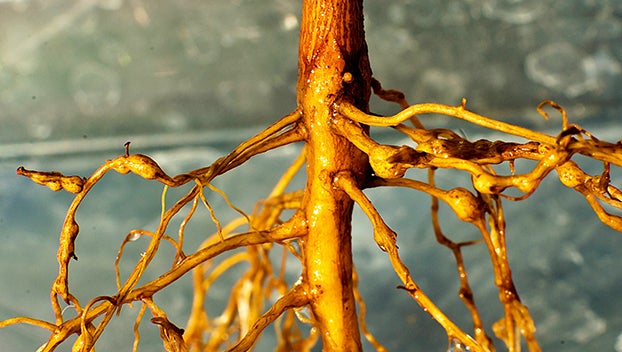TEXAS CERTIFIED EXPERT GARDENER — Fight these detrimental garden pests causing havoc down under
Published 12:04 am Wednesday, April 10, 2024

- Southern root-knot nematodes dwell beneath the soil surface and are formidable pests. Nematodes in general are responsible for billions of dollars in crop damage annually. Root-knot nematodes are by far the most prevalent and destructive of all nematodes. (farmprogress.com)
|
Getting your Trinity Audio player ready...
|
Monday evening, we returned to SETX from our family visit in North Alabama, and as is typical for us, created a hectic week.
How is it that in four days, things go sideways in the garden, lawn and around the house in general?
Our lawn looked as if it hadn’t been mowed in a month, the vegetable garden and flower beds have become weed patches, but here is the kicker. Returning home from work late Tuesday afternoon (exhausted from the recent trip), I noticed a swarm of bees near the house and decided to investigate — albeit from a distance.
Bees were making themselves at home, taking up residence beneath our house. Sadly, this is not the first time this has occurred. A friend (master gardener and master beekeeper) graciously removed the bees over the course of several days.
There were 12 honeycombs associated with the removal of this one colony. Fortunately, the bees were unharmed during the removal process and relocated so they can continue pollinating plants.
This is the time of year bees swarm as they look to create new colonies, so please consider contacting local beekeepers who often are glad to assist gardeners. Always remember, bees are ‘the good guys’ meaning they are beneficial insects!
Our discussion today is the final installment of pests that do not fall into the “good guy” category! One despicable pest is responsible for billions of dollars in crop damage annually, with the three most destructive being: root-knot, cyst and root lesion nematodes but note there are numerous others. Root-knot nematodes are by far the most prevalent and destructive of all nematodes.
Root-knot Nematodes – are microscopic worms. Characteristics signs of an infestation include wilted leaves and stunted new growth. Remove the plant and observe the roots, tiny galls appear around the roots. To reduce their numbers, gardeners can mix a can of beer and one cup of molasses, pour into a hose end sprayer (20 gallon), then thoroughly soak the area. The “yeasty, sweet” mixture will attract bees and other pollinators, and the excess run-off will kill the nematodes.
Slugs & Snails – are slithering, slimy creatures that devour plant leaves quickly. Hiding during the day and feasting on plants at night. Many gardeners make snail/slug traps by placing shallow dishes (or jar lids) containing beer (cheapest available at the market) strategically around plants. They will slide right into the beer trap. Check traps often, discard pests and refill. Some gardeners might opt to make the traps by scattering eggshells, “used” coffee grounds, or sand by sprinkling around plants. Note that most of these slimy critters don’t like herbs, such as rosemary, lavender, or sage and begonias, nasturtium and lantana keep them away as well.
Spider Mites – if plant leaves become ‘spotty and yellow’, check for these insects beneath the leaves. They can be difficult to get rid of but start the process by removing infested leaves (placing them into a plastic bag, sealing, and discarding into the trash). If possible, isolate the plant to stop the mites from spreading.
Spray infected plants weekly with a mixture of 1-gallon lukewarm water and adding 3 tbsp. mild soap, then wipe the leaves gently. Some plants may be sensitive to the soapy mixture, so try on one leaf before spraying the entire plant. Another option is to use organic miticides such as Pyrethrum, Cinnamite, Neem oil or Rosemary oil. Repeat every 3 days for 2 weeks, until the life cycle is disrupted, extinguishing all generations except eggs.
Squash Bugs – interplant any squash variety with companion plants such as nasturtiums, onions, marigolds, or tansy. These insects are not fond of these plants and will tend to stay away. If there is an infestation, spray the leaves with a mixture using equal parts vanilla flavoring and water.
Squash Vine Borers – infect and devastate most varieties from the cucurbit family, including squash, gourds, cucumbers, pumpkins, and melons. Injecting Bacillus thuringiensis (Bt) directly into a squash plant’s vine is the fastest way to control the problem. This should be injected after initial flowers bloom for maximum effectiveness. Using a disposable 3cc syringe, filled with 1cc of liquid Bt, inject the liquid into the squash vine stem about 1.5-inches above the soil line.
Repeat the injection in 7 to 10 days. Clean the syringe using a mixture of equal parts chlorine bleach and water. Insert the syringe’s needle into the water-bleach mixture and pull back on the syringe plunger. Push the plunger to expel the bleach solution, and repeat. The syringe and needle must be cleaned with bleach solution to prevent the spread of pathogens. Clean the syringe & needle after each plant injection.
Stink Bugs (Brown Marmorated Stink bug) – enjoy feasting on fruits and vegetables. Mix 4 teaspoons freshly minced garlic with two cups of water, strain and pour into a sprayer, then spray affected plants. Another option is chopping garlic, then leaving bits and pieces around plants. Note each option must be reapplied after rain events. Neem oil is also highly effective at sending little the ‘buggers’ packing!
Let’s go out and grow ourselves a greener, more sustainable world, one plant at a time.
Send Certified Texas Expert Gardener John Green your questions and please continue sending comments to jongreene57@gmail.com.





